Amazon’s business model has revolutionized global commerce through a sophisticated ecosystem that combines retail, cloud computing, advertising, and logistics. At its core, Amazon operates as a customer-obsessed organization that prioritizes long-term growth over short-term profits. This strategy has enabled the company to expand from an online bookstore to “the everything store” with a market capitalization exceeding $1.7 trillion. Understanding Amazon’s business model is essential for sellers, analysts, and consumers looking to navigate or leverage the retail giant’s ecosystem in 2025.
What Amazon Is Today (Retail, 3P Marketplace, AWS, Ads, Logistics)
Amazon has evolved far beyond its origins as an online bookstore. Today, it operates as a complex ecosystem with five interconnected business segments that create powerful synergies.
Amazon Retail (1P)
As a first-party retailer, Amazon purchases products directly from manufacturers and brands, then sells them to consumers. This traditional retail model gives Amazon complete control over pricing, inventory, and the customer experience. While retail was Amazon’s original business, it now represents a smaller percentage of total sales but remains crucial for maintaining product selection and competitive pricing.
Third-Party Marketplace (3P)
The marketplace allows independent sellers to list and sell products on Amazon’s platform. This segment has grown dramatically, now accounting for over 60% of Amazon’s total sales volume. The marketplace creates a flywheel effect: more sellers bring more products, attracting more customers, which in turn attracts more sellers.
The Amazon Flywheel: Amazon’s virtuous cycle where lower prices lead to more customer visits, attracting more sellers, which increases selection and allows further price reductions through economies of scale.
Amazon Web Services (AWS)
AWS provides cloud computing infrastructure and services to businesses worldwide. Despite representing a smaller portion of Amazon’s revenue, AWS generates the majority of the company’s operating profit, effectively subsidizing other parts of the business. This high-margin segment has been critical to Amazon’s ability to invest in expansion while maintaining relatively low retail prices.
Advertising
Amazon’s advertising business has grown rapidly as the company leverages its vast customer data and purchase intent information. Retail media—advertising placed on retail websites and apps—has become a major revenue source with exceptionally high margins, similar to AWS.
Retail Media: Advertising placed on retail websites and apps that targets shoppers based on their browsing and purchase behavior.
Logistics and Fulfillment
Amazon has built one of the world’s most sophisticated logistics networks, including fulfillment centers, sortation facilities, delivery stations, and transportation fleets. This infrastructure enables fast delivery promises like Prime’s two-day, one-day, and same-day options, creating a significant competitive advantage.
Enhance Your Amazon Shopping Experience
Join Amazon Prime to unlock free fast shipping, exclusive deals, and streaming entertainment. Try it free for 30 days.
How Amazon Makes Money (1P vs 3P, AWS margins, Ads, Prime)
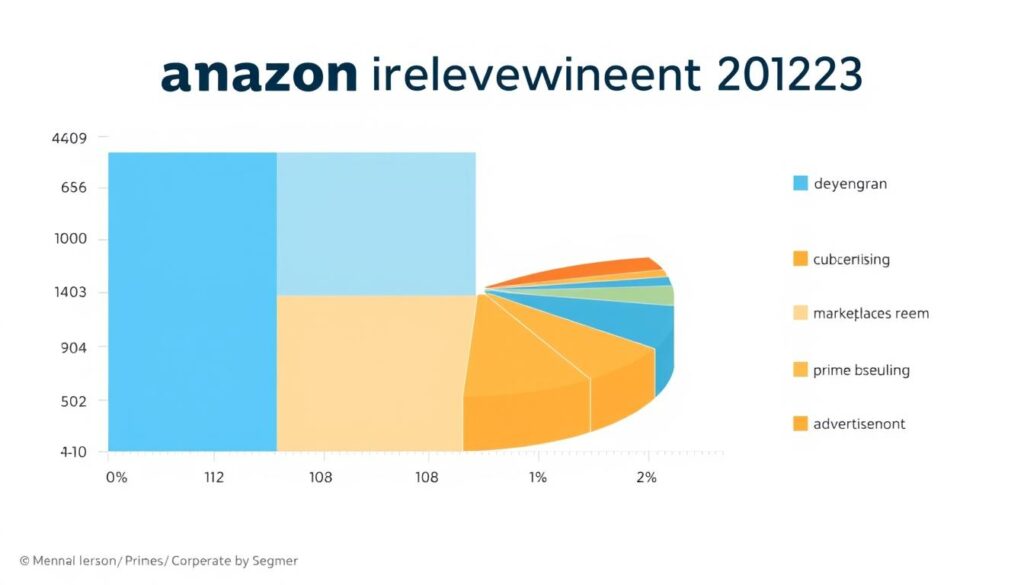
Amazon’s revenue model is diversified across multiple streams, each with different margin profiles and growth trajectories. This diversification has been key to Amazon’s ability to invest in long-term growth while maintaining financial stability.
Retail Sales (1P) vs. Marketplace (3P)
In the 1P model, Amazon buys products wholesale and sells them at retail prices, earning the retail margin. This model typically generates 10-15% gross margins but requires significant inventory investment. In contrast, the 3P marketplace model generates revenue through:
- Referral fees (typically 8-15% of the sale price)
- Fulfillment by Amazon (FBA) fees
- Monthly subscription fees from professional sellers
- Optional services like advertising and premium account management
The 3P model is significantly more profitable for Amazon, with estimated gross margins of 20-30%, while requiring less capital investment since third parties own the inventory.
AWS: The Profit Engine
AWS generates approximately 16% of Amazon’s total revenue but contributes over 50% of its operating profit. With operating margins exceeding 30%, AWS has been essential to funding Amazon’s expansion into new markets and continued investment in logistics infrastructure.
| Business Segment | Approximate Revenue Share | Estimated Operating Margin | Capital Requirements |
| Retail (1P) | 40% | 1-3% | High |
| Marketplace (3P) | 22% | 20-30% | Low |
| AWS | 16% | 30-35% | Medium |
| Advertising | 7% | 70-80% | Very Low |
| Prime Subscriptions | 7% | 10-15% | Medium |
| Other | 8% | Varies | Varies |
Advertising: The High-Margin Growth Star
Amazon’s advertising business has grown to become the third-largest digital advertising platform after Google and Meta. With estimated margins of 70-80%, advertising represents Amazon’s highest-margin business. Sellers pay to promote their products within Amazon’s ecosystem, creating a virtuous cycle where advertising revenue subsidizes lower retail prices.
Prime: The Loyalty Engine
Amazon Prime generates revenue through subscription fees ($139/year or $14.99/month in the US as of 2024). While Prime itself may not be highly profitable directly, it drives customer loyalty and increases purchase frequency. Prime members spend approximately 2-3 times more annually than non-Prime customers.
Start Selling on Amazon Today
Join over 2 million sellers worldwide on Amazon’s marketplace. Get access to hundreds of millions of customers and Amazon’s world-class fulfillment network.
Amazon’s Moats (Logistics, data/personalization, ecosystem, FBA/Buy with Prime)
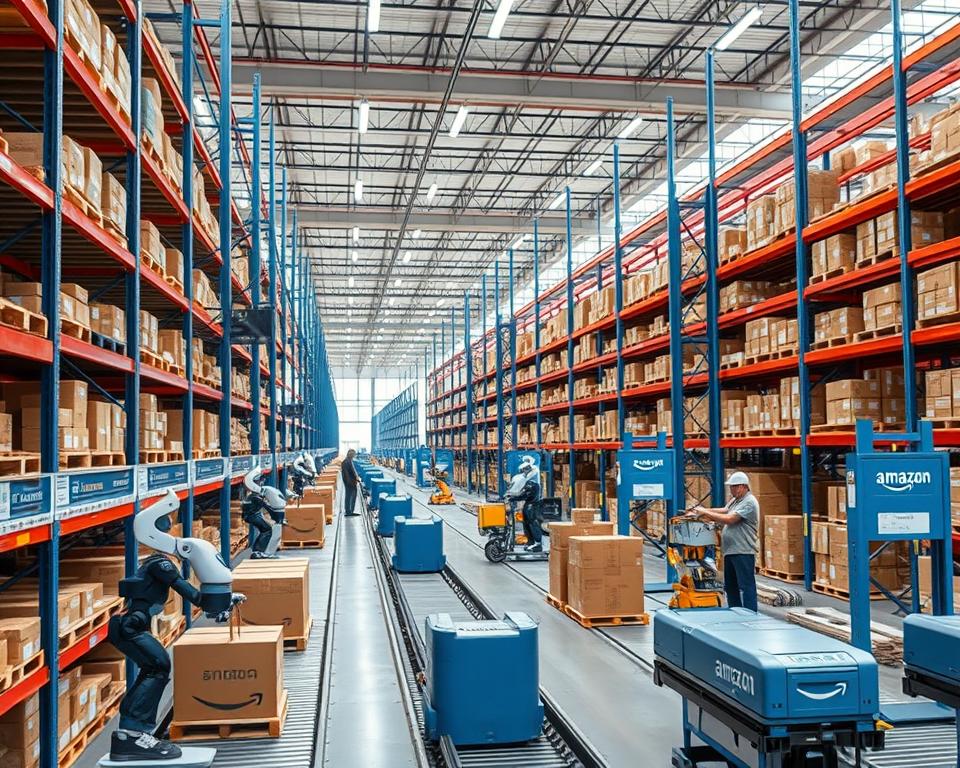
Amazon has built several powerful competitive advantages—or “moats”—that protect its business model from competitors and enable continued growth. These interconnected advantages reinforce each other, creating a formidable barrier to entry.
Logistics Network
Amazon’s fulfillment infrastructure includes over 175 fulfillment centers, 300+ delivery stations, and a growing transportation fleet. This network enables Amazon to deliver products faster and more efficiently than competitors, supporting promises like same-day and next-day delivery. The scale of this network creates significant cost advantages that smaller competitors cannot match.
Data and Personalization
With data from billions of customer interactions, Amazon has unparalleled insight into consumer preferences and purchasing patterns. This data powers personalized recommendations that drive additional sales and improve customer experience. Amazon’s recommendation engine is estimated to generate 35% of the company’s total sales.
The Amazon Ecosystem
Amazon has created an integrated ecosystem of products and services that increase switching costs for customers. Prime membership combines shipping benefits, video streaming, music, and more, making it difficult for customers to leave the Amazon ecosystem. The more Amazon services a customer uses, the more valuable Prime becomes.
Prime Benefits Ecosystem
- Free fast shipping on millions of items
- Prime Video streaming service
- Prime Music streaming
- Prime Reading e-books
- Prime Gaming (formerly Twitch Prime)
- Amazon Photos unlimited storage
- Exclusive deals and shopping events
Seller Services Ecosystem
- Fulfillment by Amazon (FBA)
- Amazon Advertising
- Buy with Prime
- Amazon Pay
- Multi-Channel Fulfillment
- Brand Registry
- A+ Content
FBA and Buy with Prime
Fulfillment by Amazon (FBA) allows sellers to store products in Amazon’s fulfillment centers, with Amazon handling storage, picking, packing, shipping, and customer service. This service creates a win-win: sellers gain access to Prime customers and logistics expertise, while Amazon increases product selection without inventory risk.
Buy with Prime extends Amazon’s fulfillment capabilities to merchants’ own websites, allowing them to offer Prime benefits to customers shopping directly on their sites. This further extends Amazon’s logistics moat beyond its own marketplace.
Leverage Amazon’s Fulfillment Network
Use Fulfillment by Amazon (FBA) to store, pack, and ship your products. Gain access to Prime customers and let Amazon handle customer service and returns.
Risks (Regulation, retail margins, competition)
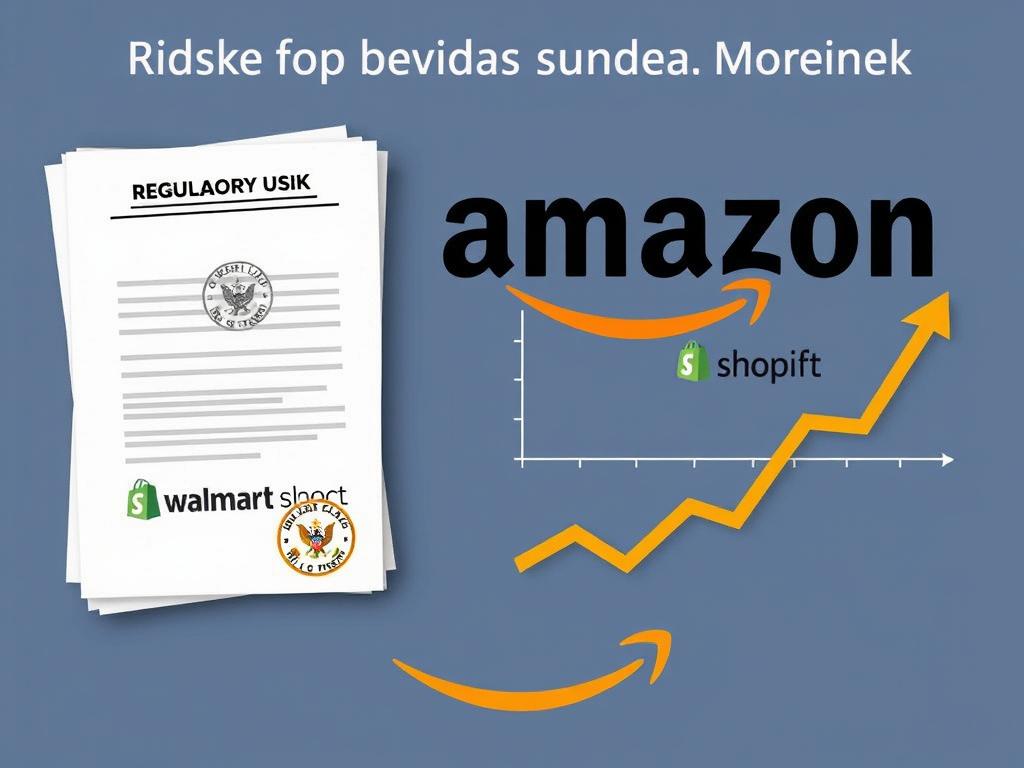
Despite its dominant position, Amazon faces several significant risks that could impact its business model in the coming years. Understanding these challenges is crucial for anyone involved with Amazon’s ecosystem.
Regulatory Scrutiny
Amazon faces increasing antitrust scrutiny in the US, EU, and other markets. Regulators are concerned about:
- Amazon’s dual role as platform operator and seller
- Use of third-party seller data to develop competing products
- Preferential treatment of its own products in search results
- Market dominance in e-commerce and cloud services
Potential regulatory actions could include forced separation of businesses, restrictions on data usage, or limitations on marketplace practices. Any of these could significantly impact Amazon’s integrated business model.
Retail Margin Pressure
Amazon’s retail business operates on thin margins, making it vulnerable to:
Strengths
- Massive scale creates purchasing power
- Sophisticated logistics reduces costs
- High-margin businesses subsidize retail
- Customer loyalty through Prime
Vulnerabilities
- Rising labor costs in fulfillment
- Increasing transportation expenses
- Price competition from Walmart and others
- Inflation affecting consumer spending
Growing Competition
Amazon faces intensifying competition across all segments of its business:
- Retail: Walmart, Target, and specialty retailers are investing heavily in e-commerce capabilities
- Marketplace: Shopify empowers merchants to build their own direct-to-consumer channels
- Cloud: Microsoft Azure and Google Cloud are gaining market share in cloud services
- Advertising: Google, Meta, and TikTok compete for digital advertising dollars
- Logistics: Walmart, Target, and Shopify are building competing fulfillment networks
As competitors improve their capabilities, Amazon’s competitive advantages may erode, particularly if regulatory actions restrict its ability to leverage synergies across business units.
Trends in 2024 (AI, international, new verticals)
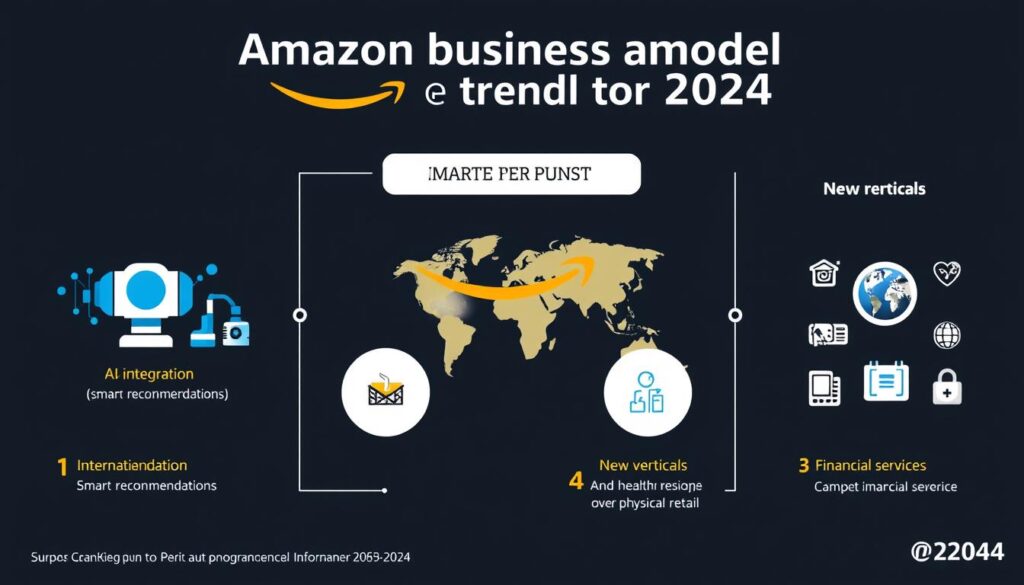
Amazon continues to evolve its business model in response to market opportunities and technological advancements. Several key trends are shaping the company’s strategy in 2024.
AI Integration Across the Business
Amazon is aggressively integrating artificial intelligence throughout its operations:
- Product Recommendations: Enhanced AI algorithms improve personalization
- Fulfillment Optimization: AI predicts demand patterns and optimizes inventory placement
- AWS AI Services: Expanded offerings for machine learning and generative AI
- Advertising: AI-powered targeting improves ad performance
- Voice Commerce: Enhanced Alexa capabilities drive voice shopping
These AI investments aim to improve efficiency, enhance customer experience, and create new revenue opportunities, particularly in AWS where Amazon competes with Microsoft and Google in providing AI infrastructure.
International Expansion Focus
While Amazon has a global presence, its market share varies significantly by region. In 2024, the company is focusing on:
| Region | Current Market Position | Growth Strategy | Key Challenges |
| India | Strong but facing competition | Local partnerships, Prime expansion | Regulatory hurdles, Reliance/Flipkart competition |
| Latin America | Growing rapidly | Logistics investment, marketplace expansion | Infrastructure limitations, local competition |
| Middle East | Expanding through Souq acquisition | Prime benefits expansion, AWS growth | Regional preferences, payment methods |
| Southeast Asia | Limited presence | Strategic investments, cross-border sales | Entrenched competitors (Shopee, Lazada) |
International expansion is crucial for Amazon’s long-term growth as North American and European markets mature. Success requires adapting the business model to local conditions while maintaining core operational excellence.
New Vertical Expansion
Amazon continues to enter new business verticals that extend its ecosystem:
- Healthcare: Expanding Amazon Pharmacy and Amazon Clinic services
- Financial Services: Payment solutions, buy-now-pay-later options, and business lending
- Physical Retail: Amazon Fresh grocery stores and Amazon Go cashierless technology
- B2B Services: Expanding Amazon Business for corporate procurement
These expansions leverage Amazon’s existing customer relationships, logistics capabilities, and technology infrastructure to enter large markets with significant growth potential.
Grow Your Business with Amazon’s Tools
Access Amazon’s business analytics and reporting tools to optimize your product listings and marketing strategies.
Takeaways for Sellers & Analysts
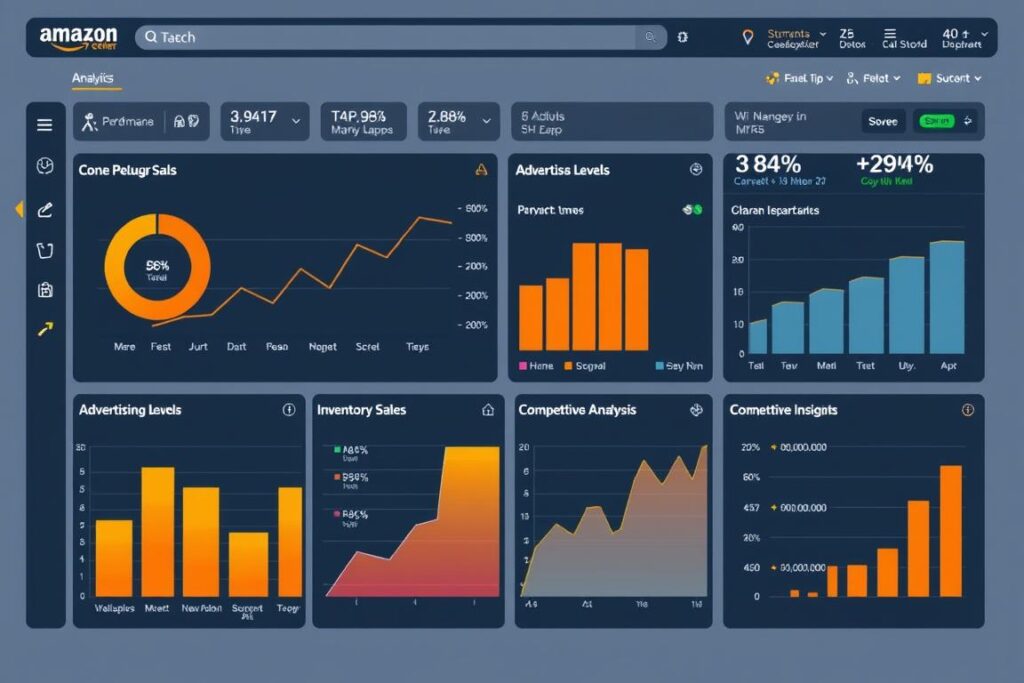
For Amazon Sellers
Understanding Amazon’s business model reveals several strategic imperatives for sellers:
Leverage Amazon’s Logistics
FBA remains a powerful advantage for sellers, enabling Prime eligibility and reducing operational complexity. Consider using Multi-Channel Fulfillment to leverage Amazon’s logistics for non-Amazon sales channels.
Invest in Advertising
As organic visibility becomes more competitive, Amazon’s advertising platform is increasingly essential for success. Develop sophisticated advertising strategies that target specific customer segments and purchase journeys.
Diversify Channels
While Amazon offers unparalleled customer access, dependency creates risk. Build direct-to-consumer capabilities and explore additional marketplaces to reduce reliance on a single platform.
For Business Analysts
Amazon’s business model offers valuable lessons for business strategy:
- Long-term Thinking: Amazon’s willingness to sacrifice short-term profits for long-term market position has been key to its success
- Ecosystem Strategy: Integrated services create customer lock-in and competitive advantages
- High-margin Subsidizing Low-margin: AWS and advertising profits enable aggressive retail pricing
- Data Leverage: Customer data becomes increasingly valuable when applied across multiple business lines
- Operational Excellence: Logistics and fulfillment capabilities create sustainable competitive advantages
Master Amazon’s Marketplace
Get the tools and knowledge you need to succeed as an Amazon seller. From product research to listing optimization and advertising.
Frequently Asked Questions
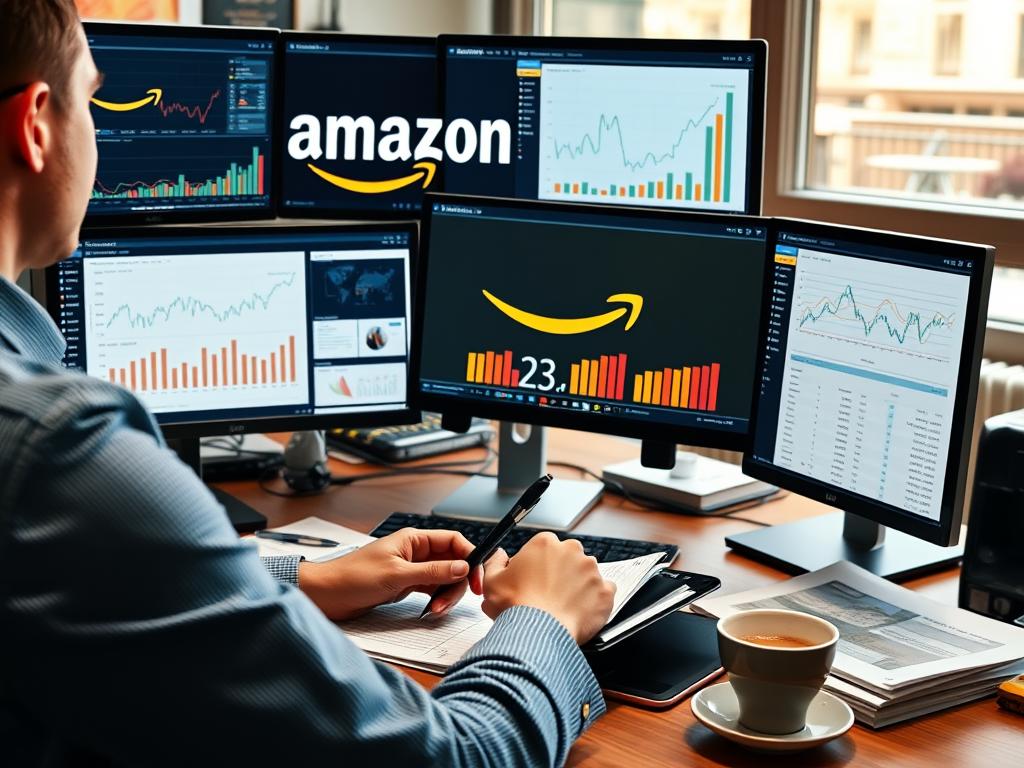
How does Amazon make most of its money?
While Amazon generates the largest portion of its revenue from retail sales (both first-party and third-party), the majority of its operating profit comes from AWS (Amazon Web Services) and advertising. These high-margin businesses effectively subsidize Amazon’s retail operations, allowing the company to maintain competitive pricing while investing in growth. In recent years, third-party seller services have become increasingly important to Amazon’s revenue mix, now accounting for over 20% of total revenue.
What is Amazon’s competitive advantage over other retailers?
Amazon’s main competitive advantages include: 1) An unmatched logistics network enabling fast delivery, 2) Vast selection through millions of third-party sellers, 3) Customer data that powers personalization, 4) The Prime membership program creating customer loyalty, and 5) Diversified revenue streams from high-margin businesses like AWS and advertising that allow Amazon to operate retail at lower margins than competitors. These advantages create a flywheel effect where each element reinforces the others.
Is Amazon profitable as a retail business?
Amazon’s retail business operates on very thin margins, particularly its first-party retail operations where Amazon buys and resells products. The North American retail segment typically achieves operating margins of 2-4%, while International retail has historically operated at a loss or break-even. The third-party marketplace is significantly more profitable, with estimated operating margins of 20-30%. Amazon’s overall profitability is driven by AWS and advertising, which subsidize the retail operations.
How does Amazon’s marketplace model benefit sellers?
Amazon’s marketplace provides sellers with access to hundreds of millions of active customers, a trusted platform with built-in trust, and sophisticated fulfillment infrastructure through FBA. Sellers can leverage Amazon’s logistics network, customer service, and Prime eligibility without building these capabilities themselves. However, sellers face challenges including intense competition, fee structures that impact margins, and dependency on Amazon’s platform rules and algorithms.
What percentage of Amazon’s sales come from third-party sellers?
As of 2024, approximately 60-65% of Amazon’s total unit sales come from third-party sellers rather than Amazon’s own retail business. This percentage has steadily increased over the past decade, rising from around 40% in 2013. Amazon has strategically shifted toward the marketplace model because it generates higher margins while requiring less capital investment, as third-party sellers own the inventory rather than Amazon.
Conclusion: The Future of Amazon’s Business Model
Amazon’s business model continues to evolve, balancing the core retail and marketplace operations with high-margin businesses like AWS and advertising. The company’s ability to operate an integrated ecosystem creates powerful competitive advantages but also attracts regulatory scrutiny. For sellers, understanding Amazon’s incentives and strategy is crucial for long-term success on the platform.
As Amazon expands into new verticals and international markets, its fundamental approach remains consistent: customer obsession, long-term thinking, and operational excellence. The company’s willingness to experiment, accept failures, and continuously innovate ensures that its business model will continue to evolve in response to market opportunities and competitive threats.
Whether you’re a seller looking to leverage Amazon’s platform, an analyst studying its business strategy, or a consumer interested in how the company works, understanding Amazon’s business model provides valuable insights into one of the world’s most influential companies.
Ready to Succeed on Amazon?
Get started with the tools, knowledge, and products you need to build a successful Amazon business in 2024.